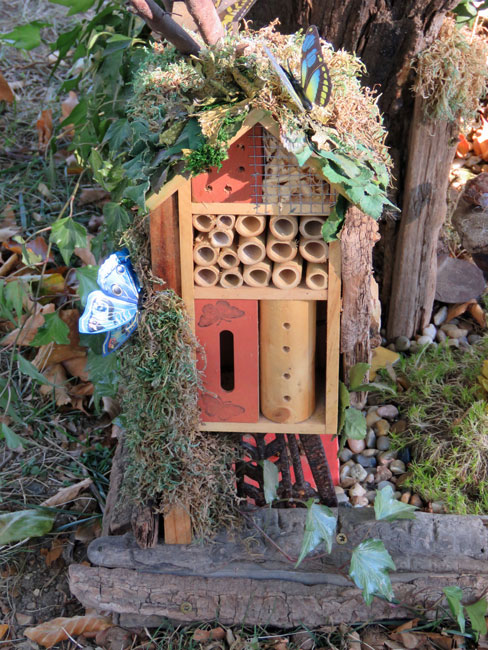
dragonfly from “Twisted Sisters Magical Menagerie” by Kristen Thornton
Last week, Janet, Tim and I visited the annual Wee Faerie outdoor art exhibit at the Florence Griswold Museum in Old Lyme, Connecticut. They have a different theme every year and the trail is open for the whole month of October. This year’s theme was Folly Woods, Awesome Wee Faerie Architecture.

Historic real-world follies are ornamental buildings designed to enhance the view at grand estates, public parks, and gardens. The fanciful forms of a folly is its function. Often inspired by the classical architecture of the ancient Greeks and Romans, folly architects also borrow decorative elements from Egypt, India, and Japan. This year, the wee faeries present FOLLY WOODS, a collection of miniature architectural masterworks for you to enjoy.
~ Folly Finder program

“Arden’s Edenesque Escape” by Vanessa Bunnell
Janet and I first started coming to these in 2011! I’ve missed a year or two for various reasons but it’s always exciting to come back and see the newest creations. Spending time with Janet is always a gift. It’s such a lovely setting on the banks of the Lieutenant River that we found ourselves captivated by the trees and flowers as much as by the little fairy buildings.

“Periwinkle’s Picturesque Pavilion” by Lynda Cmara & Bettina Rowlands

from “Periwinkle’s Picturesque Pavilion” by Lynda Cmara & Bettina Rowlands








from “Avery’s Surreal Aviary” by Madeline Kwasniewski & T. Arthur Donnelly


Listen …
With faint dry sound,
Like steps of passing ghosts,
The leaves, frost-crisp’d, break free from the trees
And fall.
~ Adelaide Crapsey
(November Night)










If you want to see some highlights from past years just click on the Florence Griswold Museum category below and you will find all my past wee faerie posts. 🧚 Some of the artists have contributed before so if you click on their names in the categories below you might find things they’ve created in past years.

As nature descends into the sacred darkness it’s the season for me to honor my departed ancestors. This is the time of year when I feel their presence the strongest. The blessings of All Hallows Eve.
May you know that absence is alive with hidden presence, that nothing is ever lost or forgotten. May the absences in your life grow full of eternal echo. May you sense around you the secret Elsewhere where the presences that have left you dwell.
~ John O’Donohue
(To Bless the Space Between Us)



































































































































